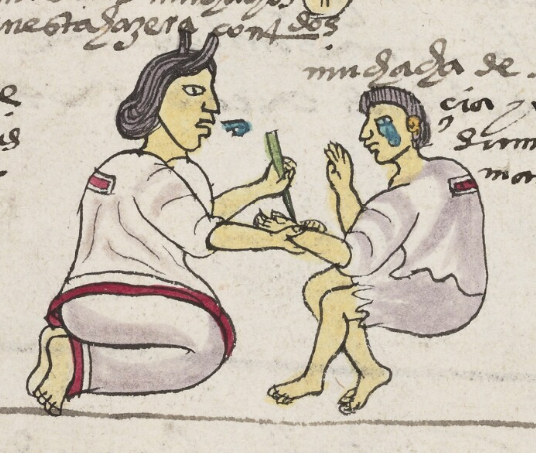huitztli (Mdz59r)
This iconographic example of maguey thorns (what we are calling huitztli, based on the Spanish gloss) is included here for the purpose of making comparisons with other thorns and their uses in hieroglyphs and glyphic elements. These maguey thorns are a group of three. They are horizontal, with the points facing to the right. The other ends are blunt. The huitztli are painted green.
Stephanie Wood
Maguey thorns in this context were used for piercing people as part of a punishment. The contextualizing image shows that a mother is punishing her daughter. Self-sacrificial bloodletting (a religious act) could possibly be done with thorns, but also with arrows and sharpened bones. That the maguey points could be used for bloodletting is suggested by the coloring of the maguey plant (metl) in the Codex Mendoza folio 10 verso--in such a way that it matches what appears to be the blood-tipped maguey thorns from the same manuscript. See examples below.
Stephanie Wood
puas di maguey
puas de maguey
Stephanie Wood
c. 1541, or by 1553 at the latest
Stephanie Wood
espinas, puas, magueyes, castigos
huitz(tli), thorn, https://nahuatl.wired-humanities.org/content/huitztli
me(tl), maguey plant, https://nahuatl.wired-humanities.org/content/metl
la espina de maguey
Stephanie Wood
Codex Mendoza, folio 59 recto, https://digital.bodleian.ox.ac.uk/objects/2fea788e-2aa2-4f08-b6d9-648c00..., image 128 of 188.
Original manuscript is held by the Bodleian Libraries, University of Oxford, MS. Arch. Selden. A. 1; used here with the UK Creative Commons, “Attribution-NonCommercial-ShareAlike 3.0 License” (CC-BY-NC-SA 3.0)






